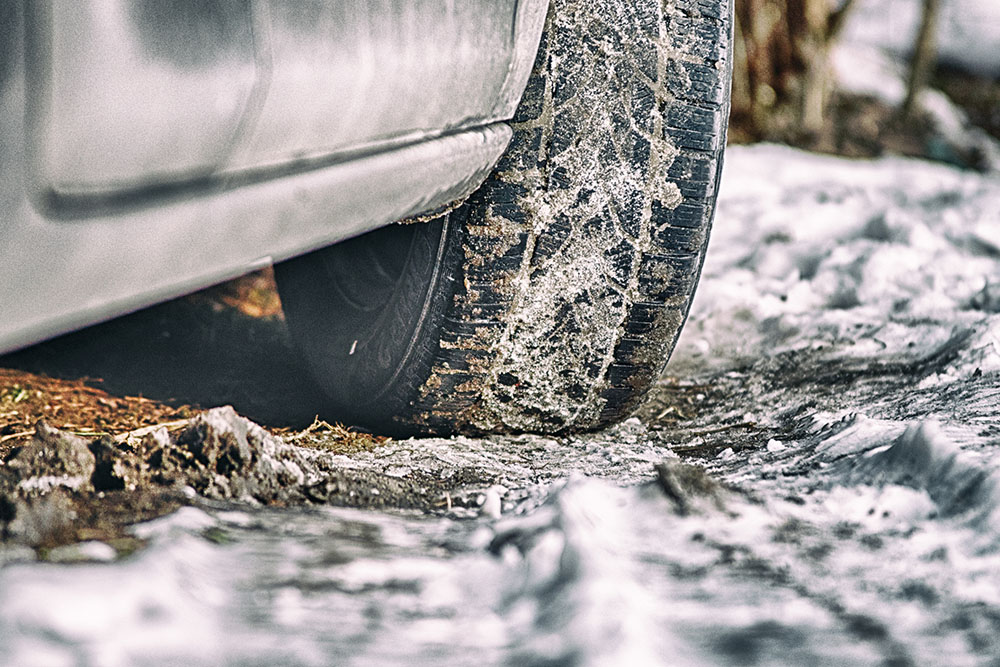Machine Versus Mountain: The Battle For (Tire) Grip

Nothing beats driving mountain roads on a stark autumn morning–light breeze, hues of red and gold, fluttering leaves.
What if those mild winter days turn from fun to foul?
“Traditional all-season tires are designed to be suitable for mild winter conditions,” said Brad Robison, senior product manager at Bridgestone Americas. “But most likely will not deliver the snow performance needed in more regular winter conditions where you will be coming across deeper snow or ice-covered roads.”
All-season tires provide long wear and traction on wet roads–the kind of conditions found in Mediterranean climates such as Central California or along the Gulf of Mexico. Yet, they are not designed specifically for road conditions at or below freezing.
Enter all-weather tires, for those drivers in areas with occasional snow or those going on a winter excursion.
“If you find yourself needing to manage driving in winter conditions such as making it up the mountains on a ski-trip,” Robison said recently, “I recommend tire products that carry the 3PMSF mark indicating the elevated winter performance.”
3 Peak Alpine Mark
The 3PMS refers to “3 Peak Mountain Snowflake.” It certifies the tire’s winter performance while being designed for year-round use.
“Drivers who are looking for this type of product do not want to make trade-offs that come with winter tires such as noise levels and needing to switch tires before and after winter,” Robison said. “Consider 3PMSF certified products if you expect to drive in winter conditions multiple times a year or need to continue daily driving routines if a rare snow storm develops.”
Another important consideration: Tread compounds in all-weather tires are not a substitute for winter tires designed to handle extreme conditions.
If drivers regularly encounter winter conditions, Robison suggested they consider investing in a set of winter tires.
“Drivers should consider 3PMSF certified products if they expect to drive in winter conditions multiple times a year or if they will need to continue their daily driving routines if a rare snow storm develops,” Robison said.
Tips for Buying Tires
Tire experts such as Robison consider the following questions when deciding on all-season tires:
-
Consider your driving “application” to determine the right tires for your vehicle. Do you live in areas prone to snow or plan to go skiing where you have an increased chance of snow or icy roads? All-weather tires can help provide the extra grip needed to handle light snow.
-
Look for 3-D siping technology. This innovation allows small grooves in the tire to interconnect where rubber presses against the road to help improve traction.
-
Ask about the alpine mark. The three-peak mountain with a snowflake symbol (3PMSF) denotes tires which can handle some snowy conditions. It signifies extra traction on surfaces with some snow.
-
Compare all-weather versus winter tires. All-weather tires are not a substitute for winter tires. Rubber compounds and tread patterns found in winter tires make them a better choice for climates with freezing temperatures.
“All-weather tires are typically defined as a tire having the 3PMSF (3 Peak Mountain Snowflake) mark certifying the winter performance while being designed for year-round use,” Robison said.
-
Do you frequent extreme cold climates? Opt for a winter tire–the tread compounds are designed for sub-freezing conditions.
-
Investigate treadwear warranty. According to Robison, advances in polymer science and innovative patterns enable all-season treads to provide strong all-season capability while also delivering a quiet ride, confident grip on rainy roads and as much as an 80,000 mile warranty.
-
Match the correct tire size. Find out the size of your original manufacturer’s tires before you choose an all-weather replacement. Tire size can be found on a label inside the door-jamb of the driver’s side door.
-
Do not let tread fall below minimum standards (in the US it's 2/32 of an inch; in Canada it is 1.6 millimeters). New tires have between 10/32 to 11/32 of an inch of tread (eight to nine millimeters in Canada).
“Once tires do not meet standards for tread depth, the features in the pattern cannot provide the same level of performance and safety,” Robison said. “And the ability to channel water and slush away from the tire’s footprint is diminished.”
“In more southern regions, traditional all-season tires should work adequately where a rare winter storm may come through with drivers being able to primarily stay at home until road conditions improve,” Robison said, “If the driver’s responsibility does not allow for waiting out a snow event, I would recommend considering a 3PMSF market product.”
Other considerations when buying any kind of tire:
- Decide what you want from your next set of vehicle tires: long wear, performance in wet weather or ability to handle extreme cold. All tires are a trade-off of those three requirements.
- Select all-season tires when you are looking for performance and longevity in mild climates. All-season tires are designed to provide comfort for family sedans, stability in rainy climates and extended wear for freeway commuters.
- Is your vehicle hauling a trailer or carrying a lot of cargo weight? Ask your tire advisor about tire “load rating.”
- Check inflation monthly to prevent uneven wear and extend the tread life of your vehicle’s tires.
- Don’t ignore the Tire Pressure Monitoring System light. It means your tires need immediate attention.
- Ask about the tire “wear” warranty no matter what type of tire you are purchasing (all-weather, all-season, all-terrain, winter, summer). Tires with quality rubber compounds and long life provide better value over product lifetime.
- Check tire tread depth throughout the entire year and replaced when needed,
Wait out a snow storm or avoid it altogether if you don’t have the proper tread. Icy road conditions are common causes of winter accidents.